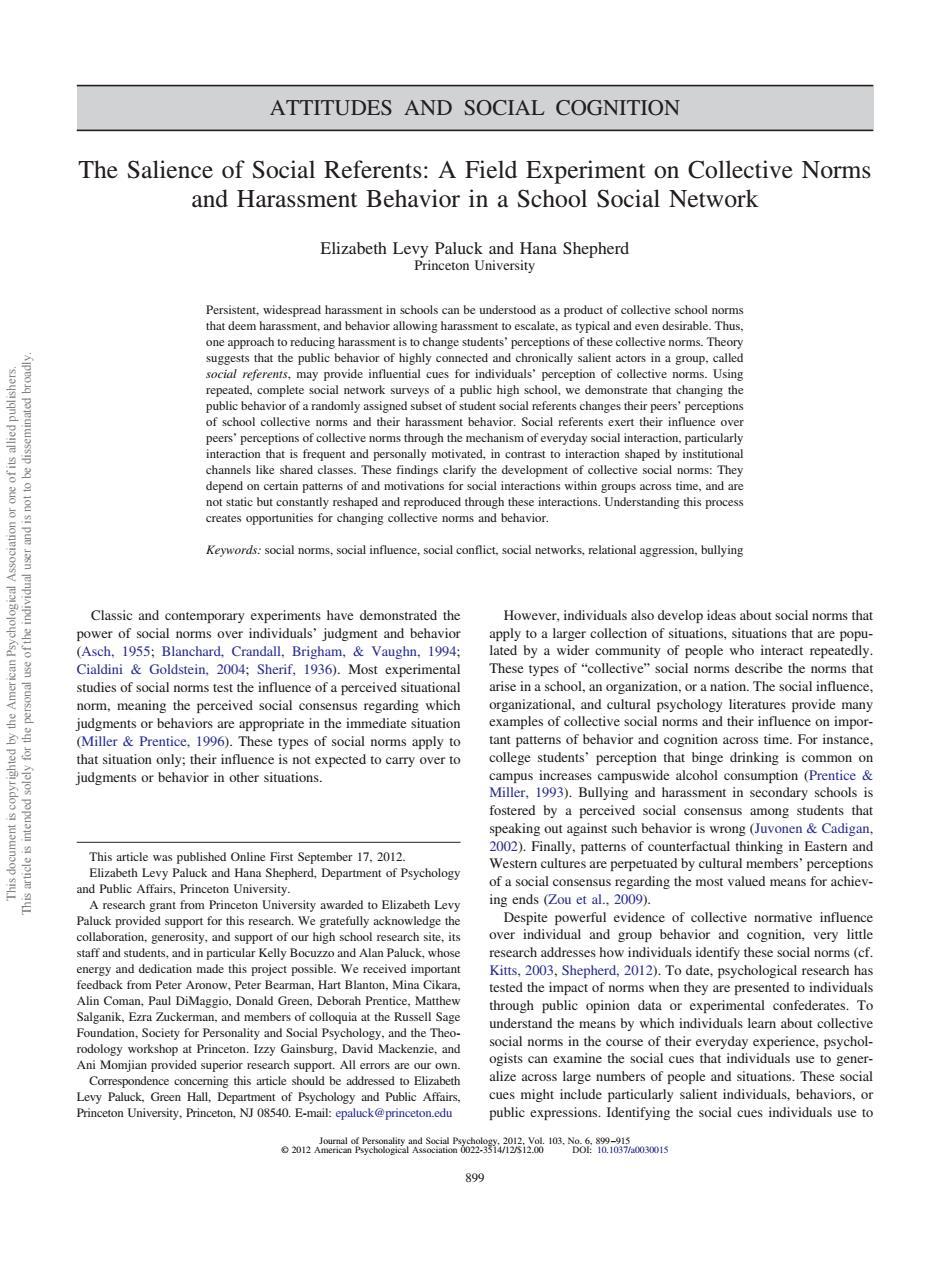正在加载图片...

ATTITUDES AND SOCIAL COGNITION The Salience of Social Referents:A Field Experiment on Collective Norms and Harassment Behavior in a School Social Network Elizabeth Levy Paluck and Hana Shepherd of school collective and their h tbehavior. eers per peatandPeonaygh ed.in for Kevwords:social norms.social influence,social conflict.social ne works,relational aggression,bullying Classic and contemporary experiments have demonstrated the However.individuals also develop ideas about social norms that s judgm Cialdini&Goldstein.2004:Sherif.936).Most experimental These types of"collectve" s describe theo as tha social os test the n of perceived types of social orms apply to iudgments or behavior in other situations such behavior iswro( rded to Elizabeth Lev Despite powerful evidence of collctive normative ty. 200 Shepherd,01).Toae,pychological ha whe they are pre d to individ ld Gre h P provided superic e across large numbers of people and situations.These social Pychology nd ATTITUDES AND SOCIAL COGNITION The Salience of Social Referents: A Field Experiment on Collective Norms and Harassment Behavior in a School Social Network Elizabeth Levy Paluck and Hana Shepherd Princeton University Persistent, widespread harassment in schools can be understood as a product of collective school norms that deem harassment, and behavior allowing harassment to escalate, as typical and even desirable. Thus, one approach to reducing harassment is to change students’ perceptions of these collective norms. Theory suggests that the public behavior of highly connected and chronically salient actors in a group, called social referents, may provide influential cues for individuals’ perception of collective norms. Using repeated, complete social network surveys of a public high school, we demonstrate that changing the public behavior of a randomly assigned subset of student social referents changes their peers’ perceptions of school collective norms and their harassment behavior. Social referents exert their influence over peers’ perceptions of collective norms through the mechanism of everyday social interaction, particularly interaction that is frequent and personally motivated, in contrast to interaction shaped by institutional channels like shared classes. These findings clarify the development of collective social norms: They depend on certain patterns of and motivations for social interactions within groups across time, and are not static but constantly reshaped and reproduced through these interactions. Understanding this process creates opportunities for changing collective norms and behavior. Keywords: social norms, social influence, social conflict, social networks, relational aggression, bullying Classic and contemporary experiments have demonstrated the power of social norms over individuals’ judgment and behavior (Asch, 1955; Blanchard, Crandall, Brigham, & Vaughn, 1994; Cialdini & Goldstein, 2004; Sherif, 1936). Most experimental studies of social norms test the influence of a perceived situational norm, meaning the perceived social consensus regarding which judgments or behaviors are appropriate in the immediate situation (Miller & Prentice, 1996). These types of social norms apply to that situation only; their influence is not expected to carry over to judgments or behavior in other situations. However, individuals also develop ideas about social norms that apply to a larger collection of situations, situations that are populated by a wider community of people who interact repeatedly. These types of “collective” social norms describe the norms that arise in a school, an organization, or a nation. The social influence, organizational, and cultural psychology literatures provide many examples of collective social norms and their influence on important patterns of behavior and cognition across time. For instance, college students’ perception that binge drinking is common on campus increases campuswide alcohol consumption (Prentice & Miller, 1993). Bullying and harassment in secondary schools is fostered by a perceived social consensus among students that speaking out against such behavior is wrong (Juvonen & Cadigan, 2002). Finally, patterns of counterfactual thinking in Eastern and Western cultures are perpetuated by cultural members’ perceptions of a social consensus regarding the most valued means for achieving ends (Zou et al., 2009). Despite powerful evidence of collective normative influence over individual and group behavior and cognition, very little research addresses how individuals identify these social norms (cf. Kitts, 2003, Shepherd, 2012). To date, psychological research has tested the impact of norms when they are presented to individuals through public opinion data or experimental confederates. To understand the means by which individuals learn about collective social norms in the course of their everyday experience, psychologists can examine the social cues that individuals use to generalize across large numbers of people and situations. These social cues might include particularly salient individuals, behaviors, or public expressions. Identifying the social cues individuals use to This article was published Online First September 17, 2012. Elizabeth Levy Paluck and Hana Shepherd, Department of Psychology and Public Affairs, Princeton University. A research grant from Princeton University awarded to Elizabeth Levy Paluck provided support for this research. We gratefully acknowledge the collaboration, generosity, and support of our high school research site, its staff and students, and in particular Kelly Bocuzzo and Alan Paluck, whose energy and dedication made this project possible. We received important feedback from Peter Aronow, Peter Bearman, Hart Blanton, Mina Cikara, Alin Coman, Paul DiMaggio, Donald Green, Deborah Prentice, Matthew Salganik, Ezra Zuckerman, and members of colloquia at the Russell Sage Foundation, Society for Personality and Social Psychology, and the Theorodology workshop at Princeton. Izzy Gainsburg, David Mackenzie, and Ani Momjian provided superior research support. All errors are our own. Correspondence concerning this article should be addressed to Elizabeth Levy Paluck, Green Hall, Department of Psychology and Public Affairs, Princeton University, Princeton, NJ 08540. E-mail: epaluck@princeton.edu Journal of Personality and Social Psychology, 2012, Vol. 103, No. 6, 899 –915 © 2012 American Psychological Association 0022-3514/12/$12.00 DOI: 10.1037/a0030015 899 This document is copyrighted by the American Psychological Association or one of its allied publishers. This article is intended solely for the personal use of the individual user and is not to be disseminated broadly